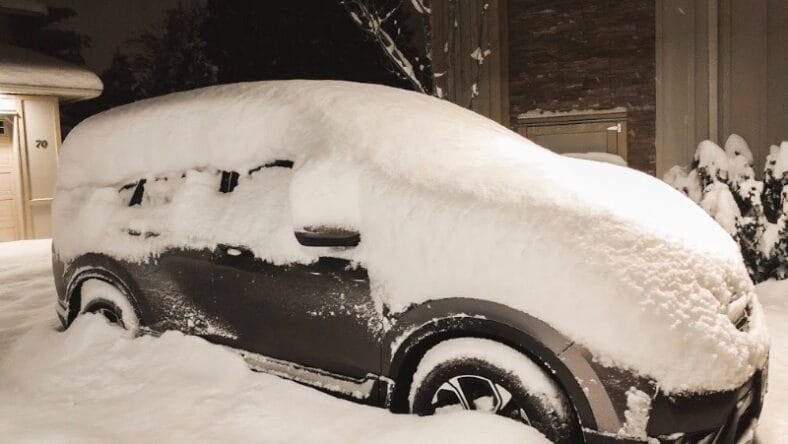Do You Need Winter Tires? How, and What to Know

Stay safe out there.
While we’re dreaming of spring flowers poking up through the ground, winter is far from over; we still have cold and unpredictable weather ahead. And with all the super storms this year, I find myself wondering if I should have invested in winter tires or “snow tires” for my vehicle. But why might they be a good investment, and what should I look for?
I live near the mountains in Vancouver, Canada, and while we don’t get a lot of snow here in the city, drive just an hour East or North and you are on mountain roads. In many parts of Canada, tires must be winter grade on certain highways from October through March.
Further Reading: How to Survive Driving in the Snow

All season tires (left) and winter tires (right. Photo: Les Schwab Tires, Greeley CO
Do I Really Need Winter Tires?
While in cities like Philadelphia, Memphis and are Seattle located at the extreme edges of the snow belt, relatively new all-season tires will probably work just fine. But the odds change as you move further into the snow belt or the all-season tires have a few years of wear on them. And who wants to gamble…especially when their collision deductible and future insurance premiums are on the table.
The Magic of Winter Tires: Rubber that Won’t Freeze
Choosing tires often means making a compromise. One tire can’t be the fastest on the track, most controllable in the snow, and longest wearing. The Ultra High-Performance tire that grips the track with tread temperatures of 200° is incompetent as its tread compound becomes like “hard plastic” at below 32°. Today’s 80,000-mile tires require tread designs and compounds that maximize long, even wear… not winter traction. And while many all-season tires, including those that come standard on new cars, touring and performance tires, address some of these issues, they still emphasize longer wear, a quieter ride or greater fuel economy…not winter traction.
Traction Control Isn’t the Same as Tire Traction
It’s also important to note that the recent advancements in electronic driver aids, such as ABS and traction control don’t provide more traction. They only help prevent drivers from over braking or overpowering the available traction of their tires. The only thing the driver can do to increase traction…to actually get more grip and control… is install better tires.
“In the simplest terms, winter tires are suitable for any driver whose “winter season” consists of average temperatures below 40 degrees and experiences anything more than infrequent snow/slush/ice conditions,” Woody Rogers, Chief Information Officer of Tire Rack told us. “Atlanta, GA, for example probably doesn’t warrant a set of dedicated winter tires. But as you move a little north to say Cincinnati, OH it’s time to consider them. At this edge of the snow belt real winter driving may be only a few times a year, but when it happens, having winter tires makes the journey so much easier.”

The M+S snowflake designation on winter tires helps buyers to know they are getting the right tire. Photo: Connie Peters
How Do I Buy Winter Tires?
Selecting tires for any season, including winter tires, can be a bit overwhelming with the sheer amount of choices available. Some cars have over 200 tire choices available! But narrowing down the winter selection is made easier; these tires carry a marking of M + S and a snowflake. For more help, the Tire Decision Guide on Tire Rack’s website makes tire selection much simpler, and allows for a function to select winter tires.
Further Reading: Can You Buy Tires Online? What You Need to Know, And What We Learned
When Should I Switch Back to All Season Tires?
“Winter tires won’t make your vehicle fall off the road and burst into flames on a warm summer day,” said Woody Rogers. “But winter tires should be removed at the end of the winter season when daily low temps are consistently above the low 40s. If temps are still falling to around freezing at the low, but the occasional daily high is pushing 50+, it’s OK to keep using the winter tires. That’s usually just a short transition at the end of the season. What’s important is to not take them off too early. A final burp of winter weather and frozen precip on the ground is where winter tires would still be the best option.”
When I asked my friends who drive locally, most do opt to purchase separate snow tires for the winter months in Canada. I use good quality M+S (mud + snow) rated all seasons because we don’t travel to the mountains often. But with more driving in the mountains in winter, I may need to consider a set of winter tires.
What is the Cost?
Snow tires can range greatly in price, depending on the size your vehicle requires and the quality of the tire and brand. Look to spend anywhere between $400 – $7000+ for a set of four winter tires. But even at the high end, that can be less than the cost of being towed out of a ditch in a blizzard. Or worse.

Have a thought or comment? Share it with us on social media! You can find us on Instagram, Facebook, Twitter and LinkedIn. And be sure to sign up for our email newsletter!
Car Shopping
Need a new car? Whether shopping for a new car or a used car we recommend using our car shopping service.
Tire Shopping
Need new tires? We recommend Tire Rack.
Car Repair
Need to get your car repaired? We recommend Repair Pal. Exclusively just for Girls Guide to Cars readers, call (877) 323-1708 to speak to RepairPal Car Genius for FREE automotive repair advice and if needed to find the right shop for you!
